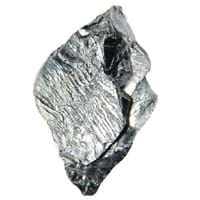Lanthanum vs Tantalum
Periodic Table
Symbol
La
Ta
Group Number
Not Available
5
13
Period Number
6
6
Block
f block
d block
Element Family
Lanthanide
Transition Metal
CAS Number
7439910
99+
7440257
99+
Space Group Name
P63/mmc
Im_ 3m
Space Group Number
194.00
5
229.00
1
Facts
Interesting Facts
- Lanthanum metal is highly malleable, ductile and sectile.
- If exposed to air Lanthanum metal oxidizes rapidly.
- Tantalum metal is known as corrosion resistance.
- Tantalum metal can easily fabricated and It is a good conductor of heat and electricity.
Sources
Found in Minerals, Mining, Ores of Minerals
Found in Minerals, Mining, Ores of Minerals
History
Who Discovered
Carl Gustaf Mosander
Anders Gustaf Ekeberg
Discovery
In 1838
In 1802
Abundance
Abundance In Universe
2 * 10-7 %
22
8 * 10-9 %
31
Abundance In Sun
~0.0000002 %
25
~-9999 %
Abundance In Meteorites
0.00 %
32
0.00 %
99+
Abundance In Earth's Crust
0.00 %
19
0.00 %
37
Abundance In Oceans
0.00 %
29
0.00 %
31
Uses
Uses & Benefits
- It has no commercial uses, but its alloys are in high demand. Lanthanum and Nickel alloy is used for the hydrogen gas storage.
- The best-known use for mischmetal alloy of Lanthanum is; as a ‘flints’ for cigarette lighters.
- Tantalum metal is mainly used in the manufacturing of electron components. Its Oxide layer acts as an insulator.
- Tantalum metal is also used in surgical transplant like replacement of bone, skull plates and as a woven gauze.
Industrial Uses
Electrical Industry, Electronic Industry
Electrical Industry, Electronic Industry
Medical Uses
NA
NA
Other Uses
Alloys, Mirror Manufacturing
Alloys
Biological Properties
Toxicity
Low Toxic
Low Toxic
Present in Human Body
Yes
Yes
In Bone
0.08 p.p.m.
24
0.03 p.p.m.
28
Physical Properties
Melting Point
920.00 °C
99+
2,996.00 °C
4
Boiling Point
3,469.00 °C
18
5,425.00 °C
4
Appearance
Physical State
Solid
Solid
Color
Silvery White
Gray Blue
Luster
NA
Metallic
Hardness
Mohs Hardness
2.50
14
6.50
5
Brinell Hardness
350.00 MPa
30
440.00 MPa
28
Vickers Hardness
360.00 MPa
26
870.00 MPa
12
Speed of Sound
2,475.00 m/s
37
3,400.00 m/s
22
Optical Properties
Reflectivity
Not Available
78.00 %
6
Allotropes
No
No
α Allotropes
Not Available
Not Available
β Allotropes
Not Available
Not Available
γ Allotropes
Not Available
Not Available
Chemical Properties
Chemical Formula
La
Ta
Isotopes
Known Isotopes
31
8
31
8
Electronegativity
Pauling Electronegativity
1.10
99+
1.50
27
Allred Rochow Electronegativity
1.08
31
1.33
22
Allen Electronegativity
Not Available
1.34
33
Electropositivity
Pauling Electropositivity
2.90
10
2.50
27
Ionization Energies
1st Energy Level
538.10 kJ/mol
99+
761.00 kJ/mol
18
2nd Energy Level
1,067.00 kJ/mol
99+
1,500.00 kJ/mol
40
3rd Energy Level
1,850.30 kJ/mol
99+
Not Available
4th Energy Level
4,819.00 kJ/mol
22
Not Available
5th Energy Level
5,940.00 kJ/mol
25
Not Available
Electrochemical Equivalent
1.73 g/amp-hr
99+
1.35 g/amp-hr
99+
Electron Work Function
3.50 eV
31
4.25 eV
21
Other Chemical Properties
Ionization, Radioactive Isotopes, Solubility
Anti Corrosion, Ionization, Radioactive Isotopes, Radioactivity, Solubility
Atomic Properties
Atomic Number
57
99+
73
99+
Electron Configuration
[Xe] 5d2 6s2
[Xe] 4f14 5d3 6s2
Crystal Structure
Double Hexagonal Close Packed (DHCP)
Body Centered Cubic (BCC)
Crystal Lattice
DHCP-Crystal-Structure-of-Lanthanum.jpg#100
BCC-Crystal-Structure-.jpg#100
Atom
Number of Protons
57
99+
73
99+
Number of Neutrons
82
99+
108
28
Number of Electrons
57
99+
73
99+
Radius of an Atom
Atomic Radius
187.00 pm
8
146.00 pm
35
Covalent Radius
207.00 pm
6
170.00 pm
25
Van der Waals Radius
240.00 pm
13
200.00 pm
28
Atomic Weight
138.91 amu
99+
180.95 amu
38
Atomic Volume
20.73 cm3/mol
16
10.90 cm3/mol
99+
Adjacent Atomic Numbers
Valence Electron Potential
40.71 (-eV)
99+
110.00 (-eV)
7
Lattice Constant
377.20 pm
28
330.13 pm
99+
Lattice Angles
π/2, π/2, 2 π/3
π/2, π/2, π/2
Lattice C/A Ratio
1.62
2
Not Available
Mechanical Properties
Density
Density At Room Temperature
6.16 g/cm3
99+
16.69 g/cm3
18
Density When Liquid (at m.p.)
5.94 g/cm3
99+
15.00 g/cm3
9
Tensile Strength
Not Available
Not Available
Viscosity
Not Available
Not Available
Vapor Pressure
Vapor Pressure at 2000 K
0.98 (Pa)
15
0.00 (Pa)
31
Elasticity properties
Shear Modulus
14.30 GPa
40
69.00 GPa
13
Bulk Modulus
27.90 GPa
99+
200.00 GPa
8
Young's Modulus
36.60 GPa
99+
186.00 GPa
13
Poisson Ratio
0.28
17
0.34
10
Other Mechanical Properties
Ductile
Ductile
Magnetic Properties
Magnetic Characteristics
Specific Gravity
6.17
99+
16.65
11
Magnetic Ordering
Paramagnetic
Paramagnetic
Electrical Properties
Electrical Property
Conductor
Conductor
Resistivity
615.00 nΩ·m
7
131.00 nΩ·m
25
Electrical Conductivity
0.01 106/cm Ω
99+
0.08 106/cm Ω
27
Electron Affinity
48.00 kJ/mol
23
31.00 kJ/mol
29
Thermal Properties
Specific Heat
0.19 J/(kg K)
32
0.14 J/(kg K)
37
Molar Heat Capacity
27.11 J/mol·K
21
25.36 J/mol·K
99+
Thermal Conductivity
13.40 W/m·K
99+
57.50 W/m·K
27
Critical Temperature
Not Available
Not Available
Thermal Expansion
12.10 µm/(m·K)
32
6.30 µm/(m·K)
99+
Enthalpy
Enthalpy of Vaporization
399.60 kJ/mol
17
753.10 kJ/mol
2
Enthalpy of Fusion
6.20 kJ/mol
99+
31.40 kJ/mol
3
Enthalpy of Atomization
431.00 kJ/mol
16
782.00 kJ/mol
3
Standard Molar Entropy
56.90 J/mol.K
23
41.50 J/mol.K
37
|
||
|
||
|












